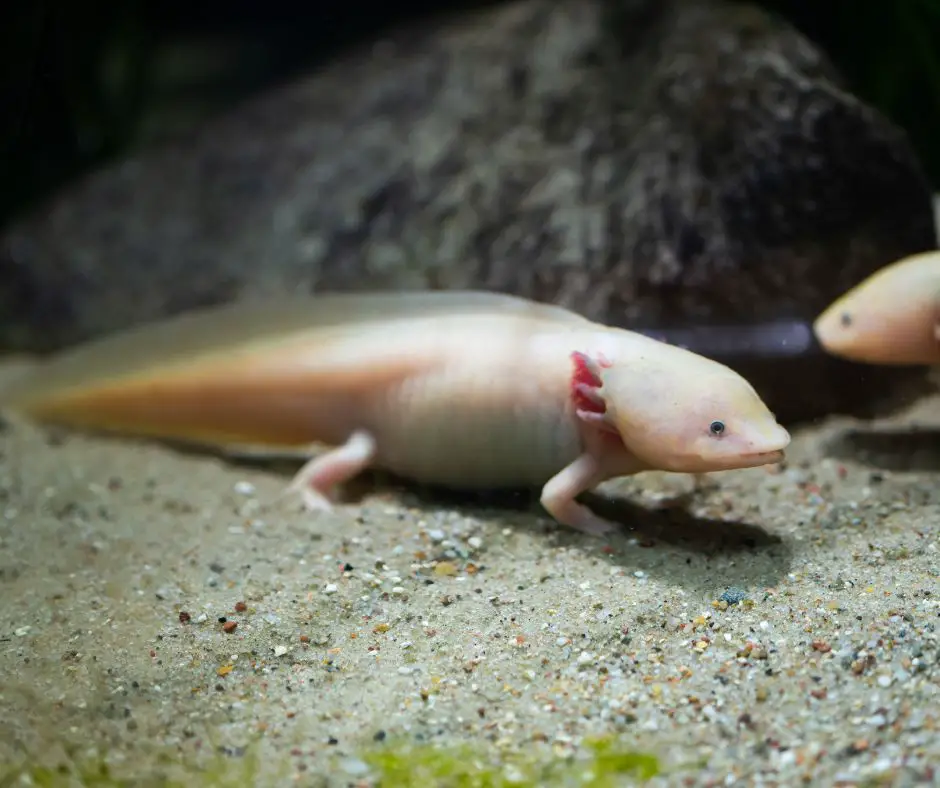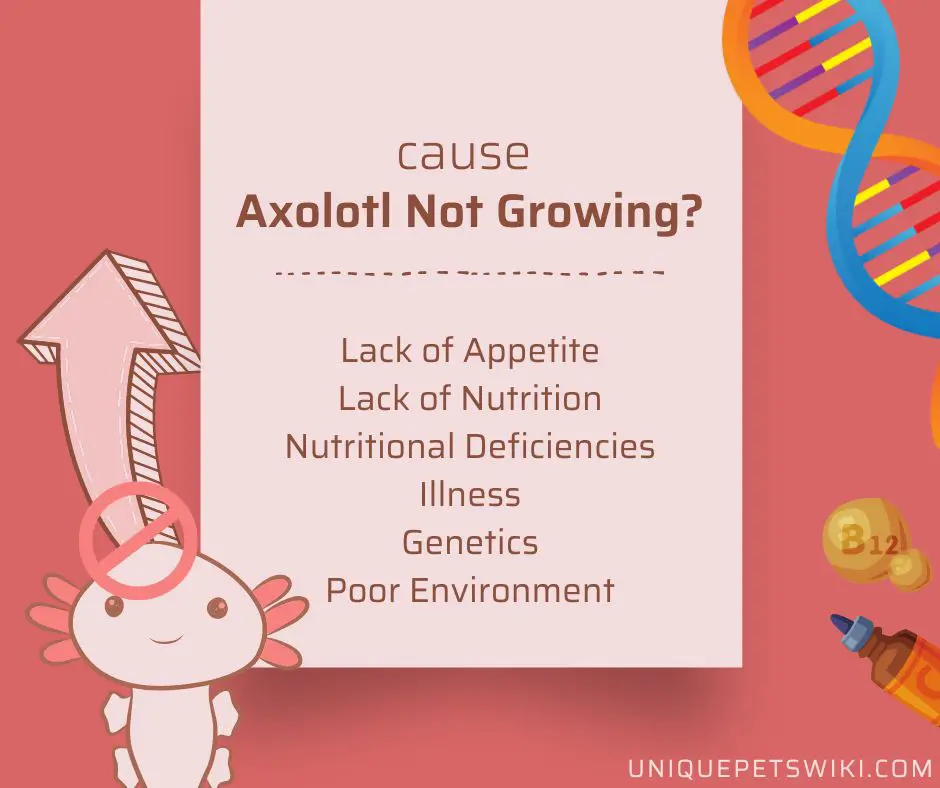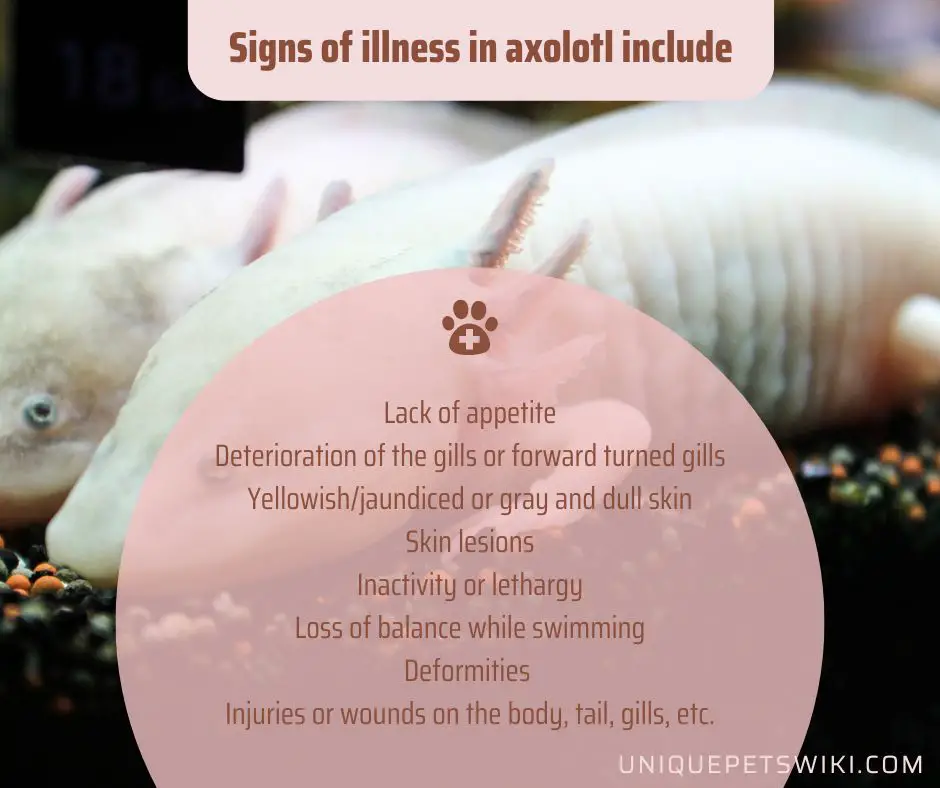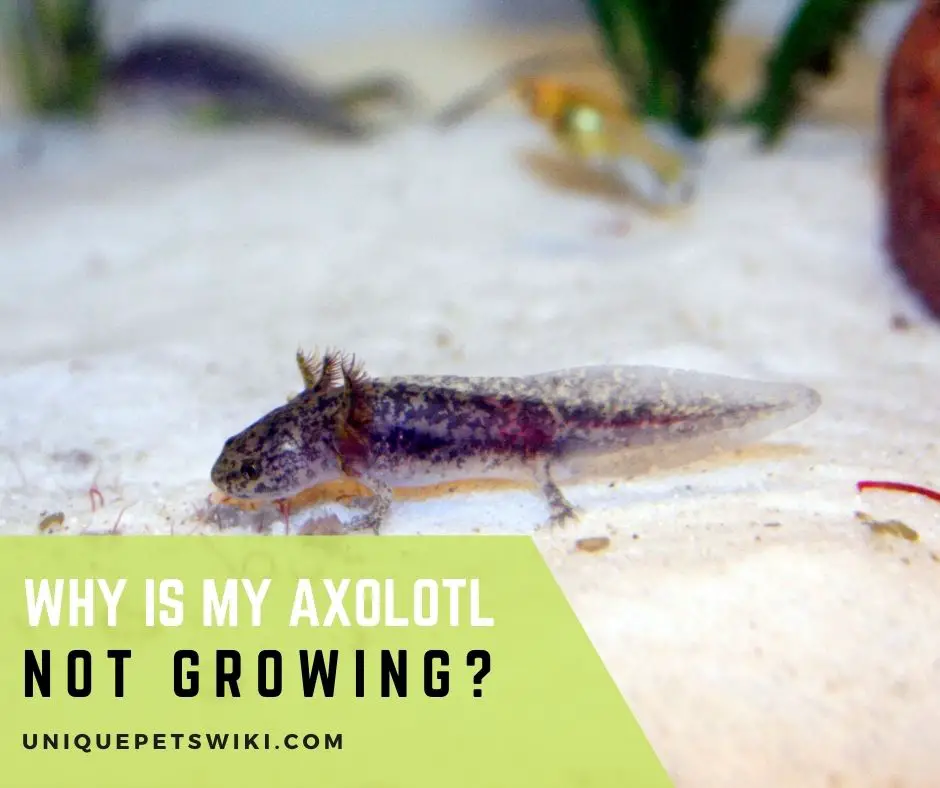Axolotls, also known as the Mexican Walking fish, are fascinating creatures that make wonderful pets.
Once you know how to maintain its tank and water parameters, most axolotls will thrive and live a happy and healthy life for nearly ten years.
However, for your axolotl to reach its optimum size, you need to provide it with the right environment.
If you have been wondering ‘why is my axolotl not growing?’, this guide is for you. Here, we will discuss why an axolotl may show stunted growth and the corrective measures you can take to rectify it.
Contents
How Big Are Axolotls As Pets?

Axolotls are salamanders having cylindrical bodies, long tails, and feathery external gills. They have short legs with four toes on the front and five on the back.
Adult axolotls reach a length of about 7-12 inches or about 22 to 30 cm measured from the tip of their noses to the end of their tails.
They weigh around 8 to 10.5 ounces or 300g in adulthood. Most axolotls reach their full size at 18-24 months from birth.
Here is a size chart to show the height and weight of axolotls from birth to adulthood:
| Age | Length | Weight |
| Newly hatched larvae | 10-13 mm or 0.5 inches | 50 g or 2 oz. |
| At one week | 20 mm or 0.8 inches | 50 to 70 g 2 to 2.5 oz |
| 2 months | 50 mm or 2 inches | 100 g or 3.5 oz |
| 6 months | 100 mm or 4 inches | 150 g or 5 oz |
| At one-year-old | 150 mm or 6 inches | 200 g 7 oz. |
| Between 18–27 months | 200 mm or 8 to 10 inches | 300 g or 8-10 oz. |
In axolotls, the growth rate is exponential, but it could slow down or speed up based on several factors, which we will discuss shortly.
An axolotl that is not growing could show some differences in the sizes mentioned in the chart above. To know how big your axolotl should be, you should know its age.
Why Is My Axolotl Not Growing?
Many factors can cause stunted growth or slow down the growth of a young axolotl. Diet, environment, genetics, etc, all play a role in its growth rate. Let us study these in detail:

Lack of Appetite
If your axolotl refuses food and starves for days together, it could be a factor in slow growth. Some Axolotls are very picky and may refuse foods like worms and pellets.
Here are some other reasons behind the lack of appetite in axolotls:
Poor water parameters – If there is too much ammonia in the water, your axolotl might have damage at its cellular level. Excess ammonia can also cause neurological issues.
If your axolotl refuses to eat for days together, check the water’s ammonia and nitrite levels.
Temperature – Axolotls prefer the water temperature between 60-64 F. However, most juvenile axolotls show faster growth in the summer months and when the water is on the warmer side.
If your house is chilly, it may lead to a slower metabolism slowing down a young axolotl’s growth.
Wrong tank mates – Sometimes, two axolotls may not get along, and one might bully the other. At other times, tankmates of other species like goldfish could also cause stress in axolotls, due to which they may stop eating.
Stress – The presence of bright light, a powerful air filter, or a bubbler that produces too many bubbles, poor water parameters, and wrong tank mates, can all be causes of stress and feeding issues.
Impaction – Your pet may have eaten something that remains undigested, causing impaction in its tummy. Impaction can also occur if an axolotl eats sand or gravel. This can result in not eating for days.
Lack of Nutrition/Nutritional Deficiencies
An underfed axolotl will not grow and thrive due to a lack of nourishment. Here are some reasons why your axolotl is not getting adequate nutrition:
Wrong food – Food suitable for juveniles may not be suitable for adult axolotls. Likewise, food with poor or low-quality ingredients may not provide your pet with the protein, vitamins, and minerals it needs to grow.
If you only feed mealworms to your pet, it may not get the calcium it needs, resulting in many health issues.
Mealworms also present other dangers – they have sharp jaws, which could hurt your axolotl’s internal organs. So, it is important to crush the mealworms before feeding them.
Inadequate feeding – Ideally, you should feed an adult axolotl for 2-5 minutes every 2-3 days. Baby axolotls need daily feeding for 2-5 minutes.
If you do not feed until your baby axolotl refuses food, it may still be hungry and want more food.
Feeding only one kind of food – Variety in food provides your axolotls with all the vital nourishment it needs. For example, your pet needs mealworms, bloodworms, small shrimp, tiny fish, and earthworms.
In addition, they need axolotl food pellets available commercially. If your pet does not receive well-rounded nourishment, it could suppress growth.
Illness

A sick axolotl will not have a healthy appetite resulting in stunted growth.
Here are some illnesses that can affect axolotls:
- Fungal/bacterial or other parasitic infection. Fungal infections can cause white cotton-like growth on the gills and skin. The parasite might be taking up all of your axolotl’s nourishment.
- As the disease worsens or spreads, your axolotl might stop eating completely and that can cause impaired growth too.
Signs of illness in axolotl include:
- Lack of appetite
- Deterioration of the gills or forward turned gills
- Yellowish/jaundiced or gray and dull skin
- Skin lesions
- Inactivity or lethargy
- Loss of balance while swimming
- Deformities
- Injuries or wounds on the body, tail, gills, etc.
Genetics
There are different varieties of axolotls, and naturally, they all have different growth rates. Some axolotls grow up to 10 to 12 inches, but the maximum recorded length in an axolotl is 18 inches!
Axolotls with smaller parents will be small in size. Sometimes, genetic anomalies can result in stunted growth in axolotls.
Genetic anomalies can result in fluid-filled skin lesions (ascites or edema) or abnormal cell growth. All these factors can result in stunted growth.
Poor Environment
As mentioned earlier, the environment has a huge impact on your axolotl’s growth. If the water has too much ammonia, nitrites, heavy metals, chlorine, etc.
Then it can result in stress, a lack of appetite, and stunted growth in your pet. If the water you use is not conditioned and dechlorinated, it can cause poor appetite.
How Can You Get Your Axolotl To Grow?
There are several ways to ensure that your axolotl grows properly and thrives. Here’s what you can do:
- Change its diet
- Check tank conditions
- See a veterinarian
Change its Diet
If you have been feeding a specific brand of axolotl pellets, you could try switching it and replacing it with another brand.
Make sure to add earthworms and bloodworms to your pet’s diet. Small shrimp and tiny fish are also nutritious.
In addition to making food changes, try to feed your axolotl more often. For example, if you feed it only once a week, try feeding it two to three times a week.
Also, increase the duration for which you feed, so, instead of 1-2 minutes, try feeding it for 3-4 minutes or until your axolotl stops eating.
Hikari Fish Food
- Perfectly balanced to offer a daily diet most carnivores love
- Higher levels of carotenoids promote brilliant colors
- Free of unwanted parasites and bacteria common with live foods
- Higher digestible protein levels that carnivores need
- Absorbs water rapidly taking on a texture of a live fish
Last update on 2022-12-29 / Affiliate links / Images from Amazon Product Advertising API
Check the Tank Conditions
The first and most important reason to check the tank conditions is to ensure the safety of the axolotl. Ammonia and nitrites can quickly build up in the tank and can be extremely harmful to axies, even lethal.
Water Parameters
Use water testing kits to check the water parameters.
Check the pH, ammonia, nitrites, and water temperature. Here are the ranges:
- Water temperature – 16 to 18 degrees C or 60-64 F
- Water pH – 7.4 to 7.6
- Ammonia and nitrites – 0
API Water Test Kit
- Contains one (1) API FRESHWATER MASTER TEST KIT 800-Test Freshwater Aquarium Water Master Test Kit, including 7 bottles of testing solutions, 1 color card and 4 glass tubes with cap
- Helps monitor water quality and prevent invisible water problems that can be harmful to fish and cause fish loss
- Accurately monitors 5 most vital water parameters levels in freshwater aquariums: pH, high range pH, ammonia, nitrite, nitrate
- Designed for use in freshwater aquariums only
- Use for weekly monitoring and when water or fish problems appear
Last update on 2022-12-30 / Affiliate links / Images from Amazon Product Advertising API
Keep an Eye on Tank Mates
Sometimes, another axolotl may be bullying the smaller/juvenile axolotl. Other tank mates of other species, such as certain varieties of fish, might cause your pet stress.
If that is the case, it is best to house your axolotl in another tank.
Please note: the ideal tank size for a single axolotl is 20-gallons, and for two axolotls, it is at least 50-75 gallons.
SeaClear Acrylic Aquarium Combo Set
- Combo includes aquarium, reflector and electrical 24" light fixture
- Acrylic aquariums are clearer than glass, 17 times stronger, and only half the weight!
- More impact resistant and less prone to chipping or cracking than glass, making it safer around children and pets
- Safe for Salt or Freshwater
- You won't believe how your fish and decorations will pop when viewing this beautiful SeaClear aquarium
Last update on 2022-12-29 / Affiliate links / Images from Amazon Product Advertising API
See a Veterinarian to Check Your Pet’s Health
If your axolotl is still not growing or appears sick after doing all of the above, please see an experienced vet who specializes in exotic pets.
Your axolotl may need medicine for a fungal or bacterial infection or even a surgical procedure to eliminate impaction. Once the root cause is eliminated, your axolotl will start eating normally.
Conclusion – Why Is My Axolotl Not Growing?
An axolotl not growing properly can be attributed to poor water parameters, dietary or nutritional deficiencies, stress, injury, or illness.
We hope the above guide helps you discover the exact root cause behind poor growth in your axolotl and take measures to overcome it.



